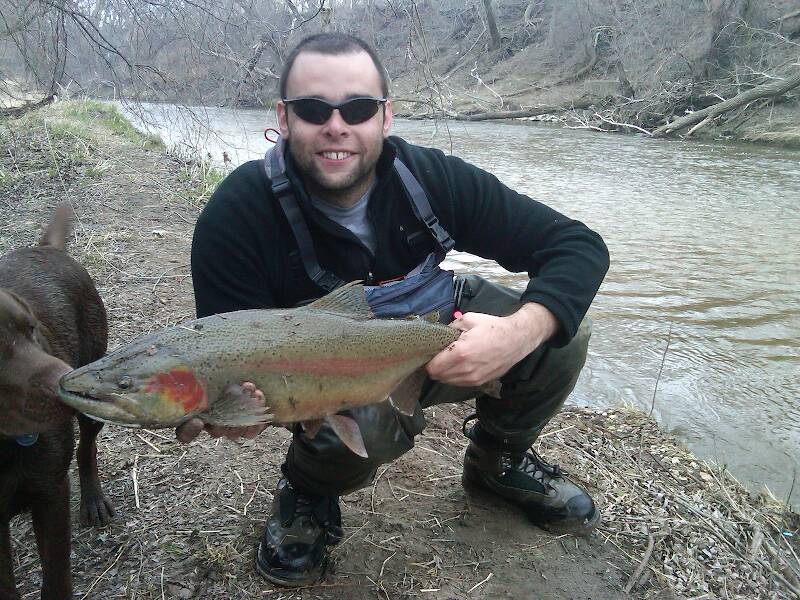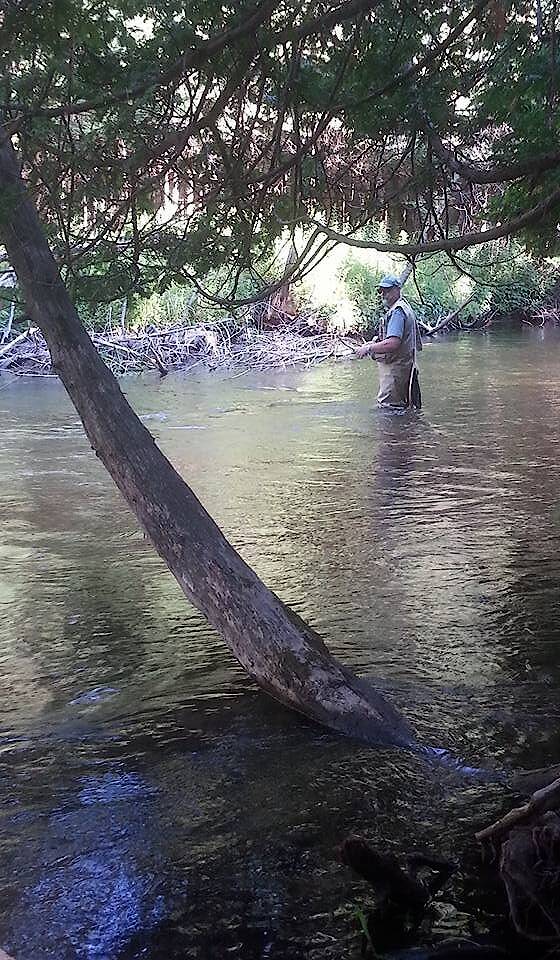
Salmonflies
Pteronarcys californica
The giant Salmonflies of the Western mountains are legendary for their proclivity to elicit consistent dry-fly action and ferocious strikes.
Featured on the forum

This one seems to tentatively key to Holocentropus, although I can't make out the anal spines in Couplet 7 of the Key to Genera of Polycentropodidae Larvae nor the dark bands in Couplet 4 of the Key to Genera of Polycentropodidae Larvae, making me wonder if I went wrong somewhere in keying it out. I don't see where that could have happened, though. It might also be that it's a very immature larva and doesn't possess all the identifying characteristics in the key yet. If Holocentropus is correct, then Holocentropus flavus and Holocentropus interruptus are the two likely possibilities based on range, but I was not able to find a description of their larvae.

Troutnut is a project started in 2003 by salmonid ecologist Jason "Troutnut" Neuswanger to help anglers and
fly tyers unabashedly embrace the entomological side of the sport. Learn more about Troutnut or
support the project for an enhanced experience here.
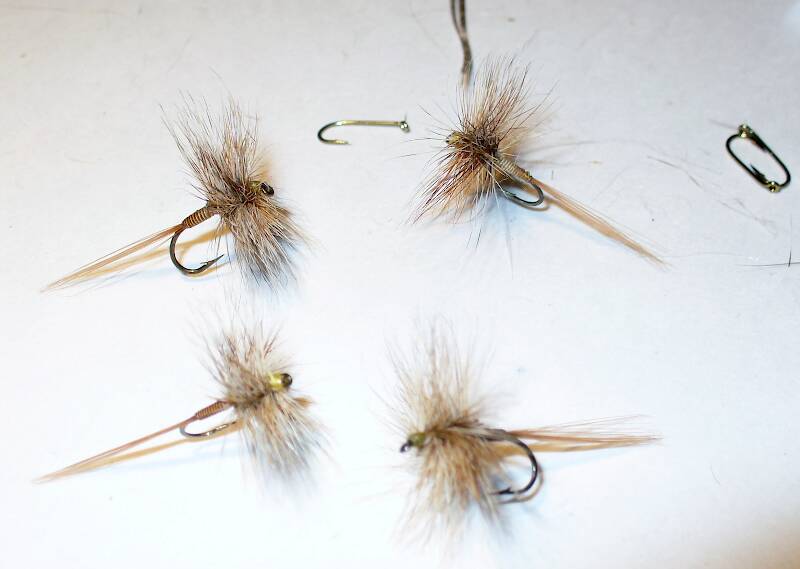
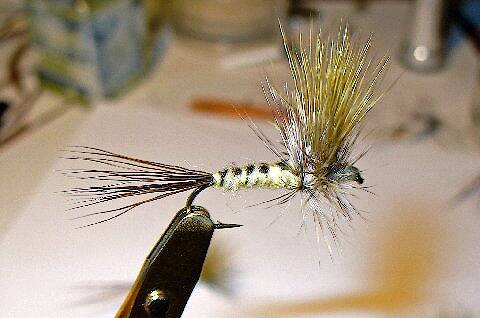
Wbranch on Jan 29, 2015January 29th, 2015, 1:21 pm EST
Here is a green drake tied with moose mane and some March Brown variants tied with microfibbets.
Catskill fly fisher for fifty-five years.
Feathers5
Posts: 287
Posts: 287
Feathers5 on Jan 30, 2015January 30th, 2015, 4:38 am EST
Those are nice. Did Dr. Tony show you how to tie those?
Kschaefer3 on Jan 30, 2015January 30th, 2015, 5:07 am EST
Thanks for posting these, Matt! I really like the look of the moose mane for larger flies. I'll need to consider that for any bigger mayfly patterns I tie up. It is hard to go wrong with the microfibbets as well. They are easy to work with and durable in my limited experience.
Wbranch on Jan 30, 2015January 30th, 2015, 6:24 am EST
Feathers5,
"Did Dr. Tony show you how to tie those?" Is that a joke? Dr. Tony ties a very nice fly but I was tying flies before he was born.
The truth be told Dr. Tony knows how to tie Hackle Stackers and I've yet to learn how to tie them,
"Did Dr. Tony show you how to tie those?" Is that a joke? Dr. Tony ties a very nice fly but I was tying flies before he was born.
The truth be told Dr. Tony knows how to tie Hackle Stackers and I've yet to learn how to tie them,
Catskill fly fisher for fifty-five years.
Lastchance on Jan 31, 2015January 31st, 2015, 6:44 am EST
Feathers5,
"Did Dr. Tony show you how to tie those?" Is that a joke? Dr. Tony ties a very nice fly but I was tying flies before he was born.
The truth be told Dr. Tony knows how to tie Hackle Stackers and I've yet to learn how to tie them,
Just playing with you. Dr. Tony speaks highly of your expertise.
Kschaefer3 on Feb 2, 2015February 2nd, 2015, 5:23 am EST
The truth be told Dr. Tony knows how to tie Hackle Stackers and I've yet to learn how to tie them,
I really want to learn the hackle stacker as well. I know a few who do well fishing them in small sizes over midges.
Kschaefer3 on Feb 2, 2015February 2nd, 2015, 10:05 am EST
To dub or not to dub? I am looking for any and all opinions on dubbing underneath the hackle on fully hackled patterns. As I understand it, traditionally they are not, but looking for personal preferences. I know the visi-dun, for instance, is dubbed underneath.
I am hosting a few friends for a tying night tomorrow. P. adoptiva and E. needhami are on the docket, both emergers and duns.
I am hosting a few friends for a tying night tomorrow. P. adoptiva and E. needhami are on the docket, both emergers and duns.
Roguerat on Feb 2, 2015February 2nd, 2015, 10:32 am EST
Would Thorax and Hair Wing Dun patterns be considered fully hackled with a dubbed under-body? Both styles get the bottom-side hackle clipped to make them low-riding in the surface film, but I do wind their hackle over a dubbed thorax per tying instructions.
Still wondering if a Blue Quill and a Little Mahogany are the same critter...same for E needhami, Apple Green Sulphur or Little Dark Hendrickson?
Still wondering if a Blue Quill and a Little Mahogany are the same critter...same for E needhami, Apple Green Sulphur or Little Dark Hendrickson?
Wbranch on Feb 2, 2015February 2nd, 2015, 10:33 am EST
Well I'm not an expert on tying flies but I think originally the Catskill style of flies did not have a dubbing built up thorax. Once the abdomen was dubbed it was stopped about 2/3 up from the bend of the hook. Then the hackle(s) where palmered to about 1/32" - 1/16" away from the eye. I don't know if dubbing under the hackle catches more trout but I do like how it looks as it makes the thorax area more robust and it adds to the floatation of the fly if the dubbing is water resistant.
Catskill fly fisher for fifty-five years.
Kschaefer3 on Feb 2, 2015February 2nd, 2015, 10:42 am EST
Rogue - That's the type of info I was looking for. For my question, let's consider them fully hackled. Thanks for the reply! Also, I believe that Blue Quill and Little Mahogany are the same, at least per Jason's wonderful encyclopedia (the value of which I am quickly learning).
Matt - Thanks! I was wondering whether flotation might be a factor. I also wonder if the trout can pick out the abdomen in all the hackle. If so, dubbing the thorax might make it slightly more realistic.
Matt - Thanks! I was wondering whether flotation might be a factor. I also wonder if the trout can pick out the abdomen in all the hackle. If so, dubbing the thorax might make it slightly more realistic.
Wbranch on Feb 2, 2015February 2nd, 2015, 11:12 am EST
Kyle,
Well I don't wrap my hackle as close together on a dubbed thorax fly as I would on a variant or typical Catskill fly. It would make little sense to dub the thorax and then wrap hackle so closely that you, or the fish, can't see it.
I also wonder if the trout can pick out the abdomen in all the hackle.
Well I don't wrap my hackle as close together on a dubbed thorax fly as I would on a variant or typical Catskill fly. It would make little sense to dub the thorax and then wrap hackle so closely that you, or the fish, can't see it.
Catskill fly fisher for fifty-five years.
Oldredbarn on Feb 3, 2015February 3rd, 2015, 12:45 pm EST
It would make little sense to dub the thorax and then wrap hackle so closely that you, or the fish, can't see it.
:)
Kyle. It's funny to me that you are tying dries and I tied some fur strip Clousers the other night for a small mouth bass outing in May?! :)
Spence
"Even when my best efforts fail it's a satisfying challenge, and that, after all, is the essence of fly fishing." -Chauncy Lively
"Envy not the man who lives beside the river, but the man the river flows through." Joseph T Heywood
"Envy not the man who lives beside the river, but the man the river flows through." Joseph T Heywood
Kschaefer3 on Feb 4, 2015February 4th, 2015, 4:57 am EST
It would make little sense to dub the thorax and then wrap hackle so closely that you, or the fish, can't see it.
:)
Kyle. It's funny to me that you are tying dries and I tied some fur strip Clousers the other night for a small mouth bass outing in May?! :)
Spence
The tables have turned :). I have been having way too much fun tying dries lately to think about streamers. Plus, my streamer box is plenty full. I always liked fishing dries, but maybe didn't understand the obsession. I think I'm starting to get it now...
Entoman on Feb 4, 2015February 4th, 2015, 6:53 am EST
Kyle,
Actually, it's a pretty good idea in some cases. First, if you ever clip the underside hackle when in need of a flush floating fly, you'll be glad that dubbing is there. Even if you don't, the dubbing will influence the color and add a little bulk for the thicker thorax that many mayflies have, especially the ephemerellids. Not all the fibers will be trapped, no matter how dense the hackle. Tie them up both ways with the same turns of hackle and you will notice the difference quite easily. The practice also allows for sparser hackle if need be. I know some anglers that don't bother with spinner patterns for PMD's. They claim to run into them so "infrequently";) that they just clip the bottom hackle and the wings out of a Red Quill they have on hand for other hatches.
A K Best is perhaps more responsible than anyone for reviving interest in traditionally collared mayfly patterns. He advises starting hackle with a little bit of the web retained to simulate thoracic bulk. He has also innovated in many other ways. His selection of materials, proportions and tying methods are quite unique and always purposeful. While many would consider his methods heretical and frankly a bet messy looking, I must admit they're damned effective. Once you get his techniques down it is by far the easiest and fastest way to tie a dry fly. The way he applies wings is brilliant. You may want to check him out.
It would make little sense to dub the thorax and then wrap hackle so closely that you, or the fish, can't see it.
Actually, it's a pretty good idea in some cases. First, if you ever clip the underside hackle when in need of a flush floating fly, you'll be glad that dubbing is there. Even if you don't, the dubbing will influence the color and add a little bulk for the thicker thorax that many mayflies have, especially the ephemerellids. Not all the fibers will be trapped, no matter how dense the hackle. Tie them up both ways with the same turns of hackle and you will notice the difference quite easily. The practice also allows for sparser hackle if need be. I know some anglers that don't bother with spinner patterns for PMD's. They claim to run into them so "infrequently";) that they just clip the bottom hackle and the wings out of a Red Quill they have on hand for other hatches.
A K Best is perhaps more responsible than anyone for reviving interest in traditionally collared mayfly patterns. He advises starting hackle with a little bit of the web retained to simulate thoracic bulk. He has also innovated in many other ways. His selection of materials, proportions and tying methods are quite unique and always purposeful. While many would consider his methods heretical and frankly a bet messy looking, I must admit they're damned effective. Once you get his techniques down it is by far the easiest and fastest way to tie a dry fly. The way he applies wings is brilliant. You may want to check him out.
"It's not that I find fishing so important, it's just that I find all other endeavors of Man equally unimportant... And not nearly as much fun!" Robert Traver, Anatomy of a Fisherman
Kschaefer3 on Feb 4, 2015February 4th, 2015, 7:00 am EST
Kurt - I appreciate the info/advice and will check out A K Best.
Like this?
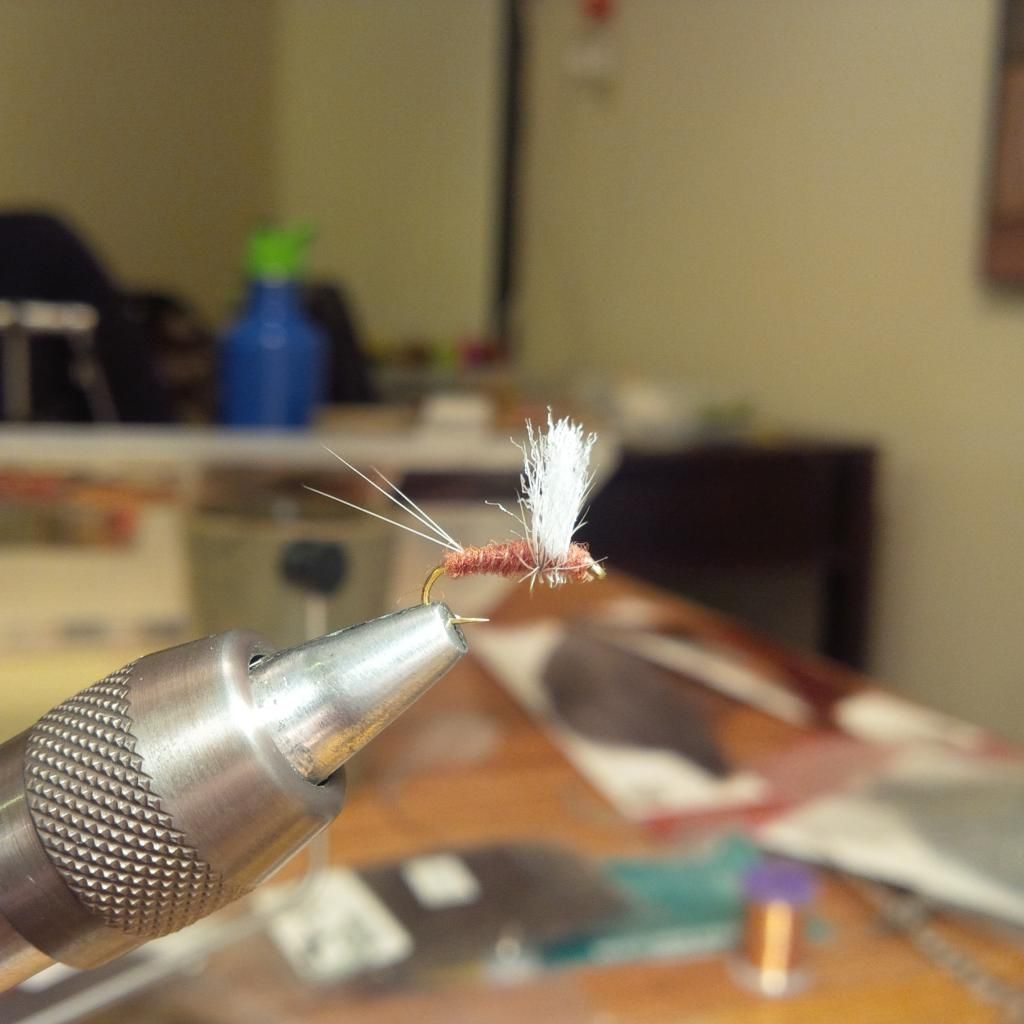
Not the greatest, but it was my first attempt at a "thorax dun". I doubt I tied it to the specs of the actual pattern, and didn't criss cross my hackle (didn't want that spread out, messy look), but I'm happy enough to fish it.
Actually, it's a pretty good idea in some cases. First, if you ever clip the underside hackle when in need of a flush floating fly, you'll be glad that dubbing is there.
Like this?

Not the greatest, but it was my first attempt at a "thorax dun". I doubt I tied it to the specs of the actual pattern, and didn't criss cross my hackle (didn't want that spread out, messy look), but I'm happy enough to fish it.
Entoman on Feb 4, 2015February 4th, 2015, 7:08 am EST
Yes, but I'd only do it streamside if needed. The thorax fly also makes a decent full hackled fly for the riffles. You can always cut 'em out but you can't put 'em back...:)
"It's not that I find fishing so important, it's just that I find all other endeavors of Man equally unimportant... And not nearly as much fun!" Robert Traver, Anatomy of a Fisherman
Kschaefer3 on Feb 4, 2015February 4th, 2015, 7:12 am EST
That one is for the spring creeks I fish, so I went ahead and clipped them straight away. I am usually fishing risers over flat, slow water and like low riding patterns.
I fish some freestones north of me though, and will consider tying them fully hackled and only clipping if need be. I like the idea of stream side modifications.
I fish some freestones north of me though, and will consider tying them fully hackled and only clipping if need be. I like the idea of stream side modifications.
Wbranch on Feb 4, 2015February 4th, 2015, 7:46 am EST
Kurt,
My point in this comment was not meant to imply that I wouldn't dub the thorax because I do on 90% of my dry flies. What I was trying to convey to Kyle is that I don't palmer the hackle so closely together that the hackle obscures, and defeats, the reason for the dubbing. I agree strongly that the dubbed thorax adds to the floatation qualities of the fly. Both flies are TMC 100 #18. There are no more than four turns of hackle on either one.
Oops! I just noticed the BWO thorax dun has a straight eye and a true Model Perfect bend so I'm thinking it is one of my Orvis "Big Eye" hooks.
See how the thorax dubbing shows through clearly between the hackle wraps?
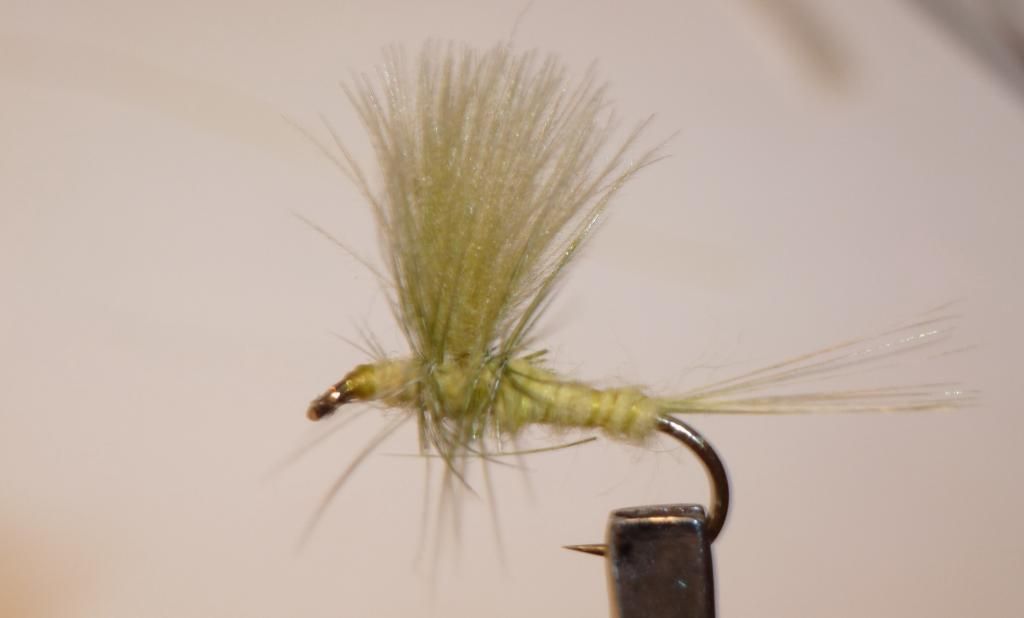

It would make little sense to dub the thorax and then wrap hackle so closely that you, or the fish, can't see it.
My point in this comment was not meant to imply that I wouldn't dub the thorax because I do on 90% of my dry flies. What I was trying to convey to Kyle is that I don't palmer the hackle so closely together that the hackle obscures, and defeats, the reason for the dubbing. I agree strongly that the dubbed thorax adds to the floatation qualities of the fly. Both flies are TMC 100 #18. There are no more than four turns of hackle on either one.
Oops! I just noticed the BWO thorax dun has a straight eye and a true Model Perfect bend so I'm thinking it is one of my Orvis "Big Eye" hooks.
See how the thorax dubbing shows through clearly between the hackle wraps?


Catskill fly fisher for fifty-five years.
Entoman on Feb 4, 2015February 4th, 2015, 11:18 am EST
Didn't know I was quoting you, Matt. Sorry if I took it out of context. That's what I get for assuming it was Kyle's comment working off of Spence's post. ;)
A dense hackled fly like you typically see on western attractor dries would make the dubbing an extra step of questionable value. I would say the same for the nice Variant examples you posted. I certainly don't dub thoraxes on my Catskill flies. I only carry four - the light and dark Hendricksons and the Gordon and Red Quills. Even those are only a few tucked away and rarely used. For some reason, never did much damage with the Light Cahills or March Browns, so I don't bother with them any more. I do carry quite a few Best style for hatch matching and I prefer his method for the Adams as well. I've found a collar hackled fly often more effective on riffly water; particularly breezy lake conditions.. Not sure why...
A dense hackled fly like you typically see on western attractor dries would make the dubbing an extra step of questionable value. I would say the same for the nice Variant examples you posted. I certainly don't dub thoraxes on my Catskill flies. I only carry four - the light and dark Hendricksons and the Gordon and Red Quills. Even those are only a few tucked away and rarely used. For some reason, never did much damage with the Light Cahills or March Browns, so I don't bother with them any more. I do carry quite a few Best style for hatch matching and I prefer his method for the Adams as well. I've found a collar hackled fly often more effective on riffly water; particularly breezy lake conditions.. Not sure why...
"It's not that I find fishing so important, it's just that I find all other endeavors of Man equally unimportant... And not nearly as much fun!" Robert Traver, Anatomy of a Fisherman
Wbranch on Feb 4, 2015February 4th, 2015, 12:12 pm EST
Kurt,
Yep, I agree with you 100%. I've seen Humpy's (Goofus Bugs) and Salmon Fly dries that probably have 2-3 hackles palmered so tightly that it looks like a bottle brush. Any enhancement of the thorax prior to hackling would be a waste of time. Also agree, in part, about the March Browns. On the Delaware system the nymphs literally cover the bottoms of rocks in riffly water yet it is a rare day in deed to see an emergence where large numbers of duns are on the water at the same time, and trout are eating them. I can only remember twice, once on the upper East Branch, and once on the middle main stem, where there were good numbers of duns on the water and my #10 MB Compara-dun was deadly and I put a dozen 18" - 21" browns in the boat on each instance.
Here are fish from each of those instances;


A dense hackled fly like you typically see on western attractor dries would make the dubbing an extra step of questionable value. I would say the same for the nice Variant examples you posted. I certainly don't dub thoraxes on my Catskill flies. I only carry four - the light and dark Hendricksons and the Gordon and Red Quills. Even those are only a few tucked away and rarely used. For some reason, never did much damage with the Light Cahills or March Browns, so I don't bother with them any more. I do carry quite a few Best style for hatch matching and I prefer his method for the Adams as well. I've found a collar hackled fly often more effective on riffly water; particularly breezy lake conditions.. Not sure why...
Yep, I agree with you 100%. I've seen Humpy's (Goofus Bugs) and Salmon Fly dries that probably have 2-3 hackles palmered so tightly that it looks like a bottle brush. Any enhancement of the thorax prior to hackling would be a waste of time. Also agree, in part, about the March Browns. On the Delaware system the nymphs literally cover the bottoms of rocks in riffly water yet it is a rare day in deed to see an emergence where large numbers of duns are on the water at the same time, and trout are eating them. I can only remember twice, once on the upper East Branch, and once on the middle main stem, where there were good numbers of duns on the water and my #10 MB Compara-dun was deadly and I put a dozen 18" - 21" browns in the boat on each instance.
Here are fish from each of those instances;


Catskill fly fisher for fifty-five years.
Quick Reply
Related Discussions
Topic
Replies
Last Reply
Re: Three Trouble Makers at the Midwest Fly Fishing Expo the past weekend

In the Photography Board by Oldredbarn

In the Photography Board by Oldredbarn
3
Mar 11, 2014
by TNEAL
by TNEAL



